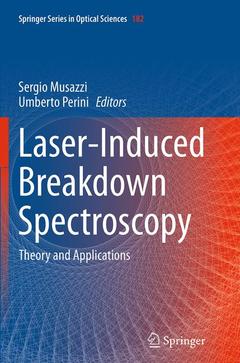Description
Laser-Induced Breakdown Spectroscopy, 2014
Theory and Applications
Springer Series in Optical Sciences Series, Vol. 182
Coordinators: Musazzi Sergio, Perini Umberto
Language: English
Subjects for Laser-Induced Breakdown Spectroscopy:
Laser-Induced Breakdown Spectroscopy
Publication date: 09-2016
Support: Print on demand
Publication date: 09-2016
Support: Print on demand
Laser-Induced Breakdown Spectroscopy. Theory and Applications
Publication date: 03-2014
565 p. · 15.5x23.5 cm · Hardback
Publication date: 03-2014
565 p. · 15.5x23.5 cm · Hardback
Description
/li>Contents
/li>Comment
/li>
This book deals with the Laser-Induced Breakdown Spectroscopy (LIBS) a widely used atomic emission spectroscopy technique for elemental analysis of materials. It is based on the use of a high-power, short pulse laser excitation. The book is divided into two main sections: the first one concerning theoretical aspects of the technique, the second one describing the state of the art in applications of the technique in different scientific/technological areas. Numerous examples of state of the art applications provide the readers an almost complete scenario of the LIBS technique. The LIBS theoretical aspects are reviewed. The book helps the readers who are less familiar with the technique to understand the basic principles. Numerous examples of state of the art applications give an almost complete scenario of the LIBS technique potentiality. These examples of applications may have a strong impact on future industrial utilization. The authors made important contributions to the developmentof this field.
Part I Fundamentals of LIBS.- Physical processes in optical emission spectroscopy.- A review of LIBS instrumental techniques.- Effect of atmospheric conditions on LIBS spectra.- Temporal evolution of the LIBS signals.- The LIBS double pulse technique.- Part II Applications of LIBS.- Analysis of solid materials by means of LIBS.- Analysis of liquids/aerosol by means of LIBS.- Detection of contaminants in soil by means of LIBS.- Forensic applications by means of LIBS.- Biological applications of LIBS.- LIBS analysis of coal.- Detection of explosives in traces.- Cultural heritage applications of LIBS.- Space applications of LIBS.- Identification of polymers by means of LIBS.
Provides readers with numerous examples of state-of-the-art applications with an almost complete scenario of the LIBS technique potentiality Reviews the LIBS theoretical aspects Helps readers who are less familiar with the technique to understand basic principles Includes examples of applications that may have strong impact on future industrial utilization (e.g. on line analysis of coal elemental composition) Includes supplementary material: sn.pub/extras
© 2024 LAVOISIER S.A.S.
These books may interest you

Laser-Induced Breakdown Spectroscopy 177.10 €



